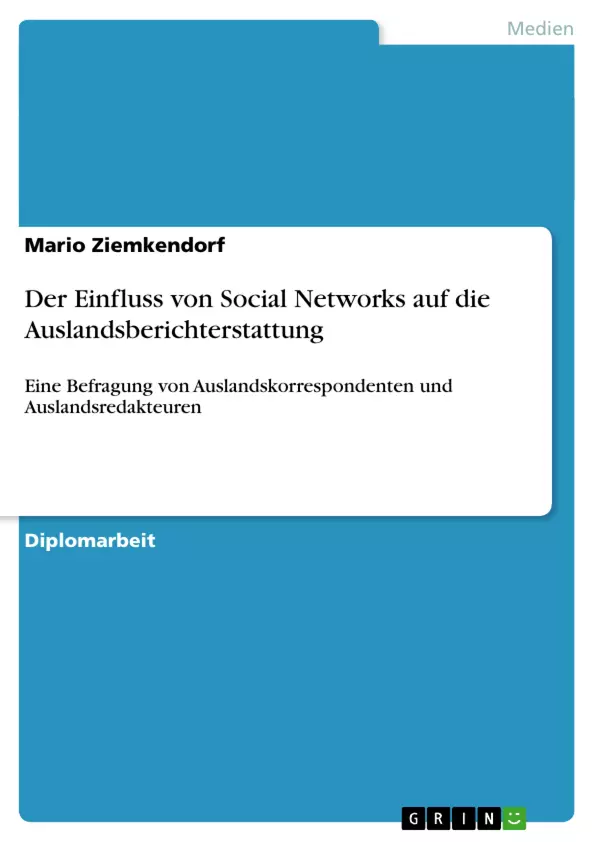Diese Studie fokussiert die Bedeutung von Social Networks [ur die Arbeit von deutschen Auslandsjournalisten. Ein weiterer Aspekt der Studie beinhaltet den Vergleich der Quellennutzung von Auslandskorrespondenten und Auslandsredakteuren. Geprüft wurde, ob und in welcher Form Social Networks für die Arbeit von Auslandsjournalisten von Relevanz sind und inwieweit sich in der Auslandsberichterstattung tätige Korrespondenten und Redakteure in ihrer Quellennutzung unterscheiden. In einer nicht repräsentativen Onlinebefragung wurden die Daten von N = 82 für deutsche Medien tätige Auslandsjournalisten erhoben. Es zeigte sich, dass Social Networks nur eine sehr geringe Bedeutung als journalistische Quelle haben. Stattdessen werden diese in erster Linie zur beruflichen Kontaktpflege genutzt. Zudem konnte ermittelt werden, dass insbesondere internationale Leitmedien aber auch deutsche Medien für die Redakteure eine größere Bedeutung [ur die Themeninspiration haben, als für die Korrespondenten. Hinsichtlich der Quellennutzung für die konkrete Beitragserstellung zeigte sich, dass die persönliche Beobachtung von Ereignissen und die Bevölkerung des Berichtslandes von den Korrespondenten signifikant häufiger als Quelle genutzt werden als von den Redakteuren. Letztere nutzen hingegen die deutschen Medien erheblich häufiger für den Informationsbezug.
This study analyses the relevance of social networks for the work of german foreign journalists. An additional concern is the compare how foreign editors and foreign correspondents may differ in using sources for their work. Reviewed was, if and in which manner social networks are relevant for the work of foreign journalists and to which extent editors and correspondents working in the foreign news field may differ in using sourees. Therefore the data from for german media working correspondents and editors were collected in a non-representative online poIl. It could be identified, that social networks are slightly relevant as an journalistic source. Rather they are primarily used to maintain job-related contacts. It could be also ascertained that particularly international leading media outlets but also german media are more relevant for editors for identiyfying new topics than for correspondents.
Inhaltsverzeichnis
- 1. Einleitung
- 1.1 Untersuchungsgegenstand und Forschungsfrage
- 1.2 Konzeption und Struktur der Arbeit
- 2. Theoretische Grundlagen
- 2.1 Social Networks
- 2.1.1 Begriffsumfeld
- 2.1.2 Terminologie
- 2.1.3 Kennzeichen und Merkmale
- 2.1.4 Handlungskomponenten
- 2.1.5 Klassifizierung
- 2.1.6 Nutzungspotentiale für Journalisten
- 2.2 Auslandsberichterstattung
- 2.2.1 Forschungsstand Auslandskorrespondenz, Auslandskorrespondenten und Auslandsredakteure
- 2.2.1.1 Entwicklung der Auslandsberichterstattung und des Korrespondentenwesens
- 2.2.1.2 Erforschung von Auslandsberichterstattung
- 2.2.1.3 Erforschung der Arbeit von Auslandskorrespondenten
- 2.2.1.4 Erforschung der Arbeit von Auslandsredakteuren
- 2.2.2 Funktionen der Auslandsberichterstattung
- 2.2.3 Die Auslandsredaktion
- 2.2.3.1 Begriffs- und Tätigkeitsbeschreibung des Auslandsredakteurs
- 2.2.3.2 Begriffs- und Tätigkeitsbeschreibung des Auslandskorrespondenten
- 2.3 Journalistische Quellennutzung
- 2.4. Das Integrative Mehrebenenmodell im Journalismus nach Esser
- 2.4.1 Subjekt-Sphäre
- 2.4.1.1 Subjektive Werte und Einstellungen
- 2.4.1.2 Berufsmotive und Berufsrollenverständnis
- 2.4.1.3 Professionalisierung
- 2.4.1.4 Soziodemografische Position
- 2.4.2 Institutions-Sphäre
- 2.4.2.1 Berufsbilder und Tätigkeitsprofile
- 2.4.2.2 Organisationsstruktur und Kompetenzverteilung
- 2.4.2.3 Redaktionelle Abläufe, redaktionelle Kontrolle und Sozialisationsmechanismen
- 2.4.2.4 Redaktionstechnologie
- 2.4.3 Medienstruktursphäre
- 2.4.3.1 Ökonomische Rahmenbedingungen des Medienmarktes und Verlegerinteressen
- 2.4.3.2 Das Presserecht Deutschlands und internationale Presserechtliche Bestimmungen
- 2.4.3.3 Presseselbstkontrolle und berufsethische Grundsätze
- 2.4.3.4 System der Journalistenausbildung
- 2.4.4 Gesellschafts-Sphäre
- 2.4.4.1 Pressefreiheit
- 2.4.4.2 Objektivitätsbegriff
- 2.4.4.3 Politische Kultur
- 2.4.4.4 Gesellschaftspolitische Rahmenbedingungen
- 2.4.4.4.1 Das (deutsche) Mediensystem und seine Abhängigkeiten
- 2.4.4.4.2 Klassifizierung von Mediensystemen
- 2.4.4.4.3 Das Mediensystem des Berichtslandes
- 2.4.4.4.4 Informationspolitische, kulturelle und infrastrukturelle Rahmenbedingungen
- 2.4.1 Subjekt-Sphäre
- 2.2.1 Forschungsstand Auslandskorrespondenz, Auslandskorrespondenten und Auslandsredakteure
- 3. Forschungsintention
- 3.1 Forschungsfragen
- 3.1.1 Untersuchungsebene 1
- 3.1.2 Untersuchungsebene 2
- 3.2. Hypothesen
- 3.2.1 Untersuchungsebene 1
- 3.2.2 Untersuchungsebene 2
- 3.3 Weitere Forschungsinteressen
- 3.1 Forschungsfragen
- 4. Methode
- 4.1 Forschungsdesign und Instrumente
- 4.2 Fragebogendesign
- 4.3 Pretest
- 4.4 Grundgesamtheit und Teilnehmerakquise
- 4.5 Stichprobenkonstruktion
- 4.6 Datenerhebung
- 4.7 Rücklauf und Kooperationsbereitschaft
- 5. Ergebnisdarstellung
- 5.1 Die Befragten
- 5.2 Ausbildung, Sprachgewandtheit, Berufserfahrung und Berufslaufbahn
- 5.2.1 Ausbildung
- 5.2.2 Sprachgewandtheit
- 5.2.3 Berufserfahrung
- 5.2.4 Berufslaufbahn
- 5.3 Journalistische Tätigkeitsmerkmale
- 5.4 Arbeitssituation
- 5.4.1 Beitragserstellung für Ressort/Redaktion
- 5.4.2 Berichtsgebiete, betreute Länderanzahl und Zuständigkeitsdauer
- 5.4.2.1 Berichtsgebiete
- 5.4.2.2 Betreute Länderanzahl
- 5.4.2.3 Zuständigkeitsdauer
- 5.5 Rahmenbedingungen
- 5.5.1 Zugang zu Informationsquellen
- 5.5.2 Behinderung der Arbeit
- 5.5.3 Zensur
- 5.5.3.1 Umgehen von Zensur
- 5.6 Informationsbeschaffung
- 5.6.1 Recherchezeit
- 5.6.2 Quellennutzung
- 5.6.2.1 Themenideen
- 5.6.2.2 Beitragsproduktion
- 2.1 Social Networks
- Die Bedeutung von Social Networks als journalistische Quelle
- Die Rolle von Social Networks für die berufliche Kontaktpflege
- Der Vergleich der Quellennutzung von Auslandskorrespondenten und Auslandsredakteuren
- Die Relevanz von internationalen Leitmedien und deutschen Medien für die Themeninspiration
- Die Nutzung von persönlichen Beobachtungen und der Bevölkerung des Berichtslandes als Quelle für die Beitragserstellung
Zielsetzung und Themenschwerpunkte
Diese Arbeit untersucht den Einfluss von Social Networks auf die Auslandsberichterstattung. Die Untersuchung konzentriert sich auf die Nutzung von Social Networks durch deutsche Auslandsjournalisten, insbesondere Auslandskorrespondenten und Auslandsredakteure.
Zusammenfassung der Kapitel
Das erste Kapitel führt in die Thematik der Arbeit ein, definiert den Untersuchungsgegenstand und formuliert die Forschungsfrage. Die Konzeption und Struktur der Arbeit werden ebenfalls erläutert. Im zweiten Kapitel werden die theoretischen Grundlagen der Studie vorgestellt. Hierbei werden die Konzepte von Social Networks, Auslandsberichterstattung, journalistische Quellennutzung und das Integrative Mehrebenenmodell im Journalismus nach Esser behandelt. Das dritte Kapitel widmet sich der Forschungsintention, den Forschungsfragen und den Hypothesen. Im vierten Kapitel werden das Forschungsdesign, die Instrumente, die Fragebogendesign, der Pretest, die Grundgesamtheit, die Stichprobenkonstruktion und die Datenerhebung beschrieben. Das fünfte Kapitel präsentiert die Ergebnisse der Studie und analysiert die Befragungsdaten. Die Arbeit endet mit der Diskussion der Ergebnisse und den Schlussfolgerungen.
Schlüsselwörter
Auslandsberichterstattung, Social Networks, Quellennutzung, Auslandskorrespondenten, Auslandsredakteure, Journalismus, Integrative Mehrebenenmodell, Medienwissenschaft
- Quote paper
- Mario Ziemkendorf (Author), 2011, Der Einfluss von Social Networks auf die Auslandsberichterstattung, Munich, GRIN Verlag, https://www.grin.com/document/189974



